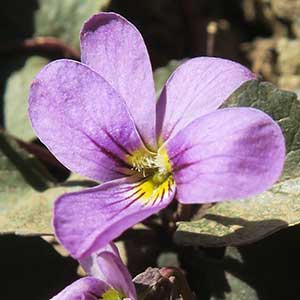Viola flettii
Viola selkirkii
Flett's violet, Olympic violet, rock violet
great-spur or long-spur or Selkirk's violet, great-spur violet, Selkirk's violet, violette de Selkirk
1–3, ascending to erect, mostly glabrous, on caudex from fleshy rhizome.
basal and cauline;
basal: 1–3;
stipules linear-lanceolate, margins entire or with glandular processes, apex acuminate;
petiole 1.5–9.7 cm, mostly glabrous;
blade purple-tinted and –veined, broadly reniform to ovate, 0.9–2.4 × 1.2–4 cm, base cordate, margins finely crenate-serrate, eciliate, apex acute to obtuse, surfaces glabrous or sparsely pubescent along veins adaxially;
cauline similar to basal except: stipules ovate to lanceolate, margins entire or shallowly laciniate;
petiole 0.7–5.9 cm, usually glabrous;
blade 0.8–2.1 × 1.2–3.1 cm.
basal, 2–12, prostrate to ascending;
stipules linear-lanceolate, margins entire, apex acute;
petiole 1.5–7 cm, not winged, glabrous or pubescent;
blade unlobed, usually ovate, rarely orbiculate, 1–5 × 1–5 cm, base cordate, margins crenate to crenulate or serrate, eciliate, apex rounded to acute, surfaces glabrous or sometimes pubescent abaxially, strigose adaxially.
1.8–7.1 cm, usually glabrous.
3–6 cm, glabrous or pubescent.
sepals lanceolate, margins eciliate, auricles 0.5–1.5 mm;
petals soft reddish violet on both surfaces, all with yellow area basally, lower 3 dark violet-veined, lateral 2 bearded, lowest with white around yellow area, 10–15 mm, spur yellow, gibbous, 0.5–2 mm;
style head bearded; cleistogamous flowers axillary.
sepals lanceolate to ovate-lanceolate, margins eciliate, auricles 1–2 mm;
petals light violet on both surfaces, lower 3 white basally and dark violet-veined, lateral 2 beardless, lowest 8–13 mm, spur pale to dark violet, elongated, 4–7 mm;
style head beardless; cleistogamous flowers on prostrate to ascending peduncles.
± spherical, 5–9 mm, glabrous.
ovoid to ellipsoid, 4–8 mm, glabrous.
dark brown to brownish purple, 2.5–3 mm.
brown, 1–2 mm.
= 24.
Viola flettii
Viola selkirkii
Viola flettii is endemic to the Olympic Mountains of northwestern Washington. C. S. McCreary (2005) noted that although morphologically and ecologically distinct, V. cuneata, V. flettii, and V. ocellata are closely related.
(Discussion copyrighted by Flora of North America; reprinted with permission.)
Viola selkirkii occurs on the southwestern coast of Greenland, north to 63ºN (L. Brouillet, pers. comm.). Presence of V. selkirkii in the Northwest Territories and Nunavut is considered doubtful (L. Brouillet et al., http://canadensys.net/vascan). K. W. Allred (2008) said that V. selkirkii was considered by W. C. Martin and C. R. Hutchins (1980) to be expected in New Mexico.
(Discussion copyrighted by Flora of North America; reprinted with permission.)


